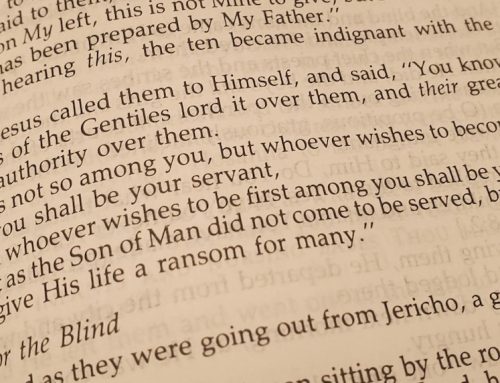The Bible is not the confusing document that many claim it to be, once it’s understood in its proper context. That’s because context is everything. A perfectly true statement by a friend can mean something entirely wrong if taken out of context. So it is with the Bible.
For example, when you read the advice in the Book of Job to “curse God and die,” that sounds outrageously out of place–until you realize that the Book of Job is simply recording the bad advice that Job’s wife gave him. When you read in Proverbs, “I will laugh at your calamity and mock when your fear comes,” it’s important to know that’s not God talking, but Solomon writing creatively as “wisdom” personified. Don’t believe me? Look it up: Proverbs 1:20-28. When you read in the gospels that “we know that God doesn’t hear the prayers of a sinner,” it sounds ludicrous on its face (aren’t we all sinners, saved by grace?), until you realize that the person speaking is not claiming to be inspired at all. He is simply defending Jesus, who had just healed him, as clearly not being a “sinner” like his accusers were suggesting.
The problem is that those of us who have been “raised in the church” have the distinct disadvantage of having to weed out teachings of men that have intertwined themselves with our understanding of the Bible. The Bible teaches against musical instrument, right? Umm, no, it doesn’t. And why would God even care about such a petty thing when there’s so much evil in the world we could be addressing as the Lord’s “hands and feet?” But it’s only when you go back and sort through the Bible for yourself that you can hope to regain a clearer perspective on what the Bible actually says–not what you thought it said all those years.
We churchgoers can be plagued with one of the biggest obstacles to clear thinking about the Scriptures: pride. It’s easy to think we have it all together, because we were raised with the Bible being taught and talked about our whole lives. But our pride–one of mankind’s most far-reaching sins–is exactly what keeps us from truly “having it all together.” Because to truly “have it all together,” we have to be humble enough to realize that we don’t. How’s that for irony?
In my quest to rethink the Bible and make my opinions my own–and I mean to really take ownership of them, not just accept someone else’s opinion on the strength of their convictions–I had to go through a process of clearing out my misunderstandings of the Bible and reading it again with fresh eyes. No notes, no cross references, no commentaries–just the words on the page as recorded faithfully by the various authors. This is what I’ve called the Clean Bible Challenge. You should try it, if you haven’t already.
For those who may have never even attempted reading the Bible for the first time, or who have been utterly confused by it when they did try, I recommend first reading the following synopsis I wrote probably about 20 years ago or more. This brief outline is intended to be a very simple Introduction to the Bible to help someone understand the big picture of what they’re reading before they even read it.
Introduction to the Bible
The Bible is not a novel, so it wasn’t meant to be read like one. Actually, it’s a lot like a collection of short, real-life stories, along with some poetry, books of wisdom, prophecy, and even personal letters. All of these different pieces of literature are about 2000 years old or more, but have been preserved for us to read today. There is no other single book in the entire world that is anything like the Bible.
The Bible was written by the hands of many different human authors under the supervision of God Himself over the course of thousands of years. What is fascinating about the Bible is that in spite of its many different authors, there are no factual errors of history or science, and there is a clear theme that holds it all together. From the opening words of Genesis to the end of Revelation, that theme is Jesus Christ.
THE OLD TESTAMENT SCRIPTURES
The Old Testament tells the story of the beginning of the world and of human history through the eyes of God’s people, called the Children of Israel. It is through this civilization that Jesus Christ would eventually come. The word “testament” means “agreement” or “covenant;” the “old covenant” was a kind of contractual agreement between Abraham and God that the world would be blessed with the coming king (Jesus) through Abraham’s descendants. In the old covenant scriptures (what people call the Old Testament) we see the rise and fall of the ancient nation of Israel, with many prophecies (predictions) about a future Messiah (anointed king) who would rescue the people of Israel from the troubles they were having.
The Old Testament is composed of ancient writings from thousands of years ago, and includes the following writings:
1) The five books of Moses (Genesis, Exodus, Leviticus, Numbers, Deuteronomy)
These books tell the story of Creation, the flood of Noah’s time, the beginnings of the Israelite nation, and it’s period of slavery in ancient Egypt. They also tell about the Israelites’ miraculous escape from Egypt, and about the laws God gave to Moses for the Children of Israel to obey. Sometimes these five books are referred to as “the Law” or the “Pentateuch.”
2) The books of history (Joshua, Judges, Ruth, 1 and 2 Samuel, 1 and 2 Kings, 1 and 2 Chronicles, Ezra, Nehemiah, Esther)
These books contain true stories that are sometimes suspenseful, occasionally unsettling, but always meaningful to us today in that they show us the character of God and how He protects those who serve Him. The history of the rise and fall of the Hebrew nation is recorded faithfully—not just their triumphs, but their failures as well, which few other ancient civilizations wrote about themselves. We have the story of how they came to settle in the land of Canaan, which is now called Israel. We’re told about their periods of faithfulness to God, and the times they turned from Him. We’re also told about their “judges” (military deliverers) and kings, about the rise of their prosperous civilization under kings David and Solomon, and ultimately about their decline into captivity under Assyria (modern Iraq), Babylon (also modern Iraq) and Persia (modern Iran).
3) The books of wisdom and poetry (Job, Psalms, Proverbs, Ecclesiastes, Song of Solomon, Lamentations)
The book of Job is famous for its story of a man persecuted by Satan himself and how he personally dealt with those difficult times. Most of the Psalms were written by King David; the book is actually a collection of individual songs. Proverbs, Ecclesiastes, and Song of Solomon were largely written by King Solomon, who recorded both witty and wise observations about human nature, moral conduct, and life itself. Lamentations was written by Jeremiah the prophet in poem form, and is about his sadness at the destruction of Jerusalem, the City of David, when it was overtaken by Babylon.
4) The prophetic books (Isaiah, Jeremiah, Ezekiel, Daniel, Hosea, Joel, Amos, Obadiah, Jonah, Micah, Nahum, Habakkuk, Zephaniah, Haggai, Zechariah, Malachi)
These books contain both predictions about Israel’s history that would come to pass many years later, and passionate instruction to the backsliding nation to turn from its errors. Israel, like mankind in general, naturally moved away from God over time, and most of the prophets wrote their books specifically to encourage the people to go back to obeying God’s laws. The prophets wrote many things about the coming of the Messiah, Jesus Christ, that happen exactly as predicted.
THE NEW TESTAMENT SCRIPTURES
The new covenant scriptures, often called the New Testament, tell us about the arrival of the Messiah. Christ means “anointed one,” since kings were often anointed with oil in the old days, and Christians look to Jesus as a spiritual “king.” The “new covenant” (or contract) fulfilled the terms of the old one (the Old Testament) and put in place a new one that would be in effect until the end of the world. In the New Testament we find the history and teachings of Jesus Christ and of his earliest followers, called his apostles (or messengers).
The New Testament is composed of the following writings from the 1st century AD:
1) The “gospels” (Matthew, Mark, Luke, John)
These four books are called the gospels because they document the “good news” of Jesus’ life from beginning to end. The word “gospel” means “good news.” They tell the story of Jesus’ life, and eventual death on the cross, from four different perspectives; Matthew, a Jewish tax collector turned follower; Mark, a Jew with Roman training; Luke, a physician; and John, a close friend (and some people think a cousin) of Jesus.
2) True stories of the Apostles’ early evangelism (Acts)
This book is called the Acts of the Apostles because it is an historical account of what Jesus’ apostles (His hand-picked messengers) did to aid in establishing Christ’s church.
3) The Apostle Paul’s letters to various first-century churches (Romans, 1 and 2 Corinthians, Galatians, Ephesians, Philippians, Colossians, 1 and 2 Thessalonians)
These letters were generally written to instruct the young churches (groups of believers) in how to behave as Christians. They cover topics like morality, faith, immersion (baptism), salvation, living a godly life of service to others, and many, many more.
4) The Apostle Paul’s letters to various individuals (1 and 2 Timothy, Titus, Philemon)
These letters were written to the individuals after whom they are named, and contain valuable, God-breathed instruction directly from Paul to these men.
5) An open letter to 1st century Christians of Jewish descent (Hebrews)
Many of the Jewish people who converted to Christianity during the early years of the church had a deep understanding of the Old Testament. This open letter was written to reassure them in their faith in Christ, and remind them, based on many Old Testament references they would easily understand, how the Jewish religion fit into God’s plan for the Messiah.
6) Letters by various individuals to first-century churches (James, 1 and 2 Peter, 1, 2, and 3 John, Jude)
Like Paul’s letters to various churches, these letters (written by the authors after whom they are named) enjoyed wide circulation among first-century believers. Since they didn’t have the Internet or the printing press, the letters were hand copied and passed from church to church to provide centuries of encouragement and instruction for Christians.
7) Book of prophecy (Revelation)
This is often the first book people turn to when they start reading the New Testament, but the numerous conflicting opinions on its interpretation can make it the most confusing. It contains a prophetic revelation to seven churches of the first century, with many appropriate lessons for our churches today. The book goes on to give us a great picture of the place He has prepared for the righteous after judgment, and develops the theme of how God’s forces will be victorious over evil in the end.
WARNING
For the rest of your life, remember that men and women have added “helpful comments” to just about every edition of the Bible that has been printed. All of them, including the words in this Introduction to the Bible, are written by fallible people. Never assume to be true what a book, preacher, pastor, friend, or teacher tells you about the Bible, without finding out for yourself if it’s true. This rule should keep you searching the Bible for the rest of your life, because there is no end of people willing to tell you what they THINK about it. Enjoy it – it provides a roadmap for life, marriage, parenting, everything. But probably not at all in the way you’ve been taught. 😉






Enjoyed your insight on this topic. I am going to try your Clean Bible Challenge!
That's awesome. I need to do it again, too. It's a good thing for everyone to do every now and then.
I have been using your "clean Bible challenge" and it has been an eye-opener for me. Especially concerning John 9:31! I cant believe how the Stanton churches have used scriptures for their doctrine and taken verses totally out of context to make it work for them. I THOUGHT I studied to know the truth but, indeed, I was studying to believe what I was taught to believe. The greatest blessing we can gain from a clean Bible challenge is HOPE. I have been able to get past believing that God is a God of SCRUTINY. NOW I can strive to… Read more »
That's awesome and inspiring! I'm so glad to see people discover the REAL God of the Bible…the one who wants a deep relationship with us.